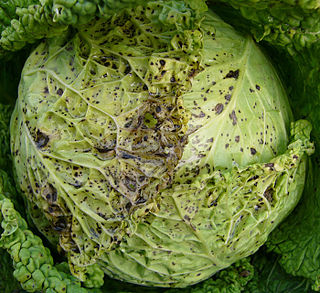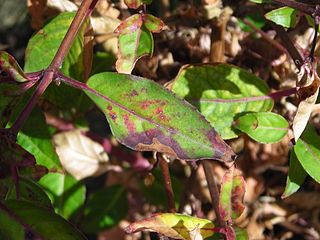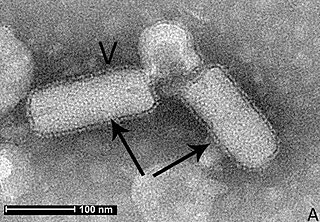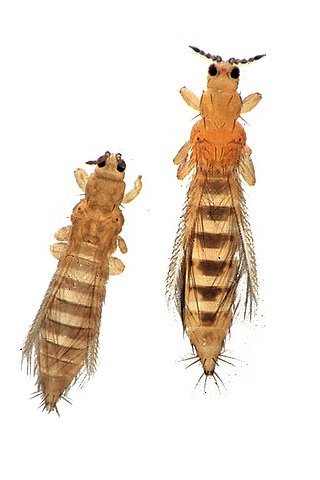Luteoviridae was a family of viruses. The family was abolished in 2020 based on evidence that its three genera and seven species unassigned to a genus belonged to two other, existing families.
Sequivirus is a genus of viruses in the order Picornavirales, in the family Secoviridae. Plants serve as natural hosts. There are three species in this genus. Diseases associated with this genus include: PYFV: vein-yellowing, yellow flecks and yellow/green mosaic symptoms in parsnip, and ‘yellow net', followed by yellow spots and leaf distortion in celery.
Lettuce necrotic yellows cytorhabdovirus (LNYV) is a plant virus belonging to the virus order Mononegavirales, family Rhabdoviridae and genus Cytorhabdovirus. It was first identified in Australia in the plant species Lactuca sativa in 1963 by Stubbs et al. Since then it has been identified in many other plant species including Datura stramonium and Nicotiana glutinosa. The virus is transmitted by the insect vector Hyperomyzus lactucae. The insect can become infected by feeding on an infected plant. It then acts as a reservoir for the virus in which it can multiply. The virus is also transmitted congenitally to its progeny.

Closterovirus, also known as beet yellows viral group, is a genus of viruses, in the family Closteroviridae. Plants serve as natural hosts. There are 17 species in this genus. Diseases associated with this genus include: yellowing and necrosis, particularly affecting the phloem. This genus has a probably worldwide distribution and includes among other viral species the Beet yellows virus and Citrus tristeza virus, rather economically important plant diseases. At least some species require vectors such as aphids or mealybugs for their transmission from plant to plant.

Turnip yellow mosaic virus (TYMV) is an isometric Tymovirus of the family Tymoviridae. Its host range is confined almost entirely to plants in the genus Brassica in western Europe, which includes cabbages, cauliflower and broccoli. Infection causes bright yellow mosaic disease showing vein clearing and mottling of plant tissues.

Beet necrotic yellow vein virus (BNYVV) is a plant virus, transmitted by the plasmodiophorid Polymyxa betae. The BNYVV is a member of the genus Benyvirus and is responsible for rhizomania, a disease of sugar beet that causes proliferation of thin rootlets, and leads to a smaller tap root with reduced sugar content. Infected plants are less able to take up water, and wilting can be observed during the warm period of the year. If the infection spreads to the whole plant, vein yellowing, necrosis and yellow spots appear on the leaves, giving the virus its name.

Impatiens necrotic spot orthotospovirus(INSV) is a plant pathogenic virus of the order Bunyavirales. It was originally believed to be another strain of Tomato spotted wilt virus, but genetic investigations revealed them to be separate viruses. It is a negative-strand RNA virus which has a tripartite genome. It is largely spread by the insect vector of the western flower thrips. The virus infects more than 648 species of plants including important horticultural and agricultural species such as fuchsia, tomato, orchids, and lettuce (especially romaine). As the name implies, the main symptom on plants is necrotic spots that appear on the leaves. The INSV virus infects by injecting the RNA the virus contains into the cell which then starts using the cell resources to transcribe what the virus RNA states. Viral infection can often result in the death of the plant. The disease is mainly controlled by the elimination of the western flower thrip vector and by destroying any infected plant material.
Prune dwarf virus (PDV) is a plant pathogenic virus of the family Bromoviridae. It causes dwarfism of leaves on certain prune and plum plants. It will also cause yellows in sour cherry, especially when present with prunus necrotic ringspot virus. There are no known transmission vectors, though the pollen of infected cherry trees has been found to infect other cherry trees a small percent of the time.

Prunus necrotic ringspot virus (PNRSV) is a plant pathogenic virus causing ring spot diseases affecting species of the genus Prunus, as well as other species such as rose and hops. PNRSV is found worldwide due to easy transmission through plant propagation methods and infected seed. The virus is in the family Bromoviridae and genus Ilarvirus. Synonyms of PNRSV include European plum line pattern virus, hop B virus, hop C virus, plum line pattern virus, sour cherry necrotic ringspot virus, and peach ringspot virus.

Benyvirus is a genus of viruses, in the family Benyviridae. Plants serve as natural hosts. There are four species in this genus. Diseases associated with this genus include: BNYVV: rhizomania.

Orthotospovirus is a genus of negative-strand RNA viruses, in the family Tospoviridae of the order Bunyavirales, which infects plants. Tospoviruses take their name from the species Tomato spotted wilt orthotospovirus (TSWV) which was discovered in Australia in 1919. TSWV remained the only known member of the family until the early 1990s when genetic characterisation of plant viruses became more common. There are now at least twenty species in the genus with more being discovered on a regular basis. Member viruses infect over eight hundred plant species from 82 different families.
Badnavirus is a genus of viruses, in the family Caulimoviridae order Ortervirales. Plants serve as natural hosts. There are 67 species in this genus. Diseases associated with this genus include: CSSV: leaf chlorosis, root necrosis, red vein banding in young leaves, small mottled pods, and stem/root swelling followed by die-back. Infection decreases yield by 25% within one year, 50% within two years and usually kills trees within 3–4 years.

Cytorhabdovirus is a genus of viruses in the family Rhabdoviridae, order Mononegavirales. Plants serve as natural hosts.

Nanovirus is a genus of viruses, in the family Nanoviridae. Legume plants serve as natural hosts. There are 11 species in this genus. Diseases associated with this genus include: stunting, severe necrosis and early plant death.
Tritimovirus is a genus of viruses, in the family Potyviridae. Plants serve as natural hosts. There are six species in this genus.

Tymovirus is a genus of viruses in the order Tymovirales, in the family Tymoviridae. Plants serve as natural hosts. There are 28 species in this genus.

Thrips tabaci is a species of very small insect in the genus Thrips in the order Thysanoptera. It is commonly known as the onion thrips, the potato thrips, the tobacco thrips or the cotton seedling thrips. It is an agricultural pest that can damage crops of onions and other plants, and it can additionally act as a vector for plant viruses.

Solemoviridae is a family of non-enveloped, positive-strand RNA viruses which infect plants. Solemoviridae is a member of the order Sobelivirales.
Safaa Kumari is a Syrian born plant virologist. She is known for developing a disease resistant variety of faba bean that is resistant to the faba bean necrotic yellows virus (FBNYV).

Beta macrocarpa, the large-fruited beet, is a species of flowering plant in the family Amaranthaceae, native to the Canary Islands and the shores of the Mediterranean. It is widely used to study beet necrotic yellow vein virus in an effort to improve the sugar beet.










